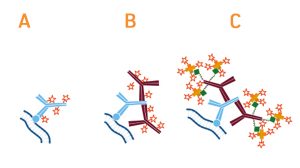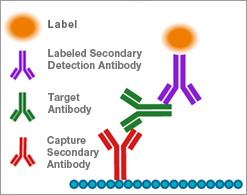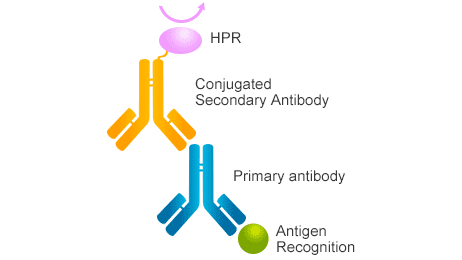Abstract
A secondary antibody aids in the detection, classification, or purification of target antigens by binding to the primary antibody, which binds directly to the target antigen. Since the vast majority of primary antibodies are produced in a few animal host species, almost all antibodies being of the IgG class, it is easy and inexpensive for manufacturers to produce and supply ready-to-use secondary antibodies that are applicable for most detection methods and systems. There are many secondary antibody options available for purity level, specificity, and label type no matter the application.
Advantages of using secondary antibodies
Secondary antibodies are used for the indirect detection of a target to which a specific primary antibody first binds. The secondary antibody must have specificity for both the antibody species and the isotype of the primary antibody being used. In addition, a secondary antibody generally has a detectable tag or another label that facilitates detection or purification.
Indirect detection of the target antigen by secondary antibodies requires more steps than direct detection by primary antibodies. However, the advantage of indirect detection is increased sensitivity due to signal amplification from multiple secondary antibodies that bind to a single primary antibody.

Furthermore, a given secondary antibody can be used with any primary antibody of the same type and host species, making it an infinitely more versatile reagent than individually labelled primary antibodies. Secondary antibodies with specificity for primary antibodies of common species are commercially available conjugated with many of the common labels, including fluorescent and enzyme conjugate options.
Indirect antigen detection using secondary antibodies offers other advantages besides diversity, flexibility and versatility:
- Allow the use of the same primary antibody with different secondary antibodies depending on the application.
- In some cases, the same secondary antibody can be used in all applications (ie, fluorescent Western blot and immunofluorescence) to validate the detection of the target antigen.
- Secondary antibodies also offer the ability to perform multiplexing or multiple labelling in experiments.
Specificity of Secondary Antibodies
Secondary antibodies are generated by immunizing a host animal with antibodies from a different species. For example, anti-mouse secondary antibodies are produced by injecting mouse antibodies into an animal other than a mouse. The goat, donkey, and rabbit are the most commonly used host species to produce secondary antibodies, but other host species can also be used.
The most common types of secondary antibodies are those generated against a pooled population of immunoglobulins from a target species. For example, immunizing a goat with purified mouse IgG will generate goat anti-mouse IgG antibodies that bind to all classes, heavy and light (H+L) chains, and fragments of mouse IgG, as well as any other molecules that share the same conserved domains. (eg, IgMs share the same kappa light chains as IgGs).
In contrast, immunizing a goat with mouse IgG1 antibodies alone will only generate antibodies specific for mouse IgG1 antibodies and molecules that share the same conserved domains. Due to the high degree of conservation in the structure of many immunoglobulin domains, class-specific secondary antibodies must be affinity purified and cross-adsorbed to achieve minimal cross-reaction with other immunoglobulins.
Using the example described above, immobilized mouse IgG1 antibodies would be used to affinity purify all goat antibodies that bind mouse IgG1. These anti-mouse IgG1 antibodies would then be purified by passing them through chromatographic columns containing IgG2a, IgG2b, IgG3, IgM, etc. mouse, to remove any antibodies that cross-react with isotypes other than IgG1.
In addition, secondary antibodies can be further purified by passage through columns containing immobilized serum proteins from species other than those used to immunize the host. This cross-adsorption method (often referred to as “Highly Cross-Adsorbed”) is an additional purification step recommended for applications where primary antibodies of multiple species will be used and when immunoglobulins or other serum proteins may be present in the samples to be tested analyze.

Secondary antibody formats
Secondary antibodies are available in 3 formats:
- ready to use liquid
- lyophilized
- With additives, such as glycerol
The format of the secondary antibody depends on how the antibody is produced and how secondary antibody suppliers choose to ship their product. Ready-to-use liquid secondary antibodies are supplied as concentrates that may require some optimization to determine their optimal working conditions. The product data sheet often provides recommended dilutions.
Ready-to-use liquid antibody concentrates should be stored at 4-8°C and are stable for up to one year if stored according to the manufacturer’s instructions. Ready-to-use liquid antibodies can be stored as aliquots at –20°C or below to extend shelf life. Aliquots can then be thawed to prepare a working solution immediately prior to use. Aliquoting prior to storage at –20°C is recommended for ready-to-use secondary antibodies, as repetitive freezing and thawing leads to loss of stainability.
Dry lyophilized concentrated secondary antibody stocks must be reconstituted with diluents before use. While dry lyophilized antibody vials are stable in that format for years at –20°C or below, after reconstitution they should be treated as liquid secondary antibodies.
Glycerol is used as an additive in antibody stock solutions to prolong their shelf life during storage at –80 to –20°C. Another common additive in commercially available antibodies is BSA, which is used as a stabilizer. Since antibody solution compatibility may not have been a key consideration when the antibody was initially purified and formulated, it is important to be aware of additives present in antibody stock solutions, as different labelling methods may be affected. to different degrees by the various additives.

